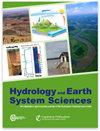Towards robust seasonal streamflow forecasts in mountainous catchments: impact of calibration metric selection in hydrological modeling
IF 5.8
1区 地球科学
Q1 GEOSCIENCES, MULTIDISCIPLINARY
引用次数: 0
Abstract
Abstract. Dynamical (i.e., model-based) methods are widely used by forecasting centers to generate seasonal streamflow forecasts, building upon process-based hydrological models that require parameter specification (i.e., calibration). Here, we investigate the extent to which the choice of calibration objective function affects the quality of seasonal (spring–summer) streamflow hindcasts produced with the traditional ensemble streamflow prediction (ESP) method and explore connections between hindcast skill and hydrological consistency – measured in terms of biases in hydrological signatures – obtained from the model parameter sets. To this end, we calibrate three popular conceptual rainfall-runoff models (GR4J, TUW, and Sacramento) using 12 different objective functions, including seasonal metrics that emphasize errors during the snowmelt period, and produce hindcasts for five initialization times over a 33-year period (April 1987–March 2020) in 22 mountain catchments that span diverse hydroclimatic conditions along the semiarid Andes Cordillera (28–37∘ S). The results show that the choice of calibration metric becomes relevant as the winter (snow accumulation) season begins (i.e., 1 July), enhancing inter-basin differences in hindcast skill as initializations approach the beginning of the snowmelt season (i.e., 1 September). The comparison of seasonal hindcasts shows that the hydrological consistency – quantified here through biases in streamflow signatures – obtained with some calibration metrics (e.g., Split KGE (Kling–Gupta efficiency), which gives equal weight to each water year in the calibration time series) does not ensure satisfactory seasonal ESP forecasts and that the metrics that provide skillful ESP forecasts (e.g., VE-Sep, which quantifies seasonal volume errors) do not necessarily yield hydrologically consistent model simulations. Among the options explored here, an objective function that combines the Kling–Gupta efficiency (KGE) and the Nash–Sutcliffe efficiency (NSE) with flows in log space provides the best compromise between hydrologically consistent simulations and hindcast performance. Finally, the choice of calibration metric generally affects the magnitude, rather than the sign, of correlations between hindcast quality attributes and catchment descriptors, the baseflow index and interannual runoff variability being the best predictors of forecast skill. Overall, this study highlights the need for careful parameter estimation strategies in the forecasting production chain to generate skillful forecasts from hydrologically consistent simulations and draw robust conclusions on streamflow predictability.实现山区集水区稳健的季节性溪流预报:水文建模中校准指标选择的影响
摘要。动态(即基于模型的)方法被预报中心广泛用于生成季节性流量预报,这些方法建立在基于过程的水文模型基础上,需要对参数进行规范(即校准)。在此,我们研究了校核目标函数的选择在多大程度上会影响用传统的集合水流预测(ESP)方法生成的季节性(春夏)水流后报的质量,并探讨了后报技能与水文一致性(以水文特征的偏差来衡量)之间的联系。为此,我们使用 12 种不同的目标函数(包括强调融雪期误差的季节性指标)对三种流行的概念性降雨-径流模型(GR4J、TUW 和 Sacramento)进行了校准,并在半干旱安第斯山脉(南纬 28-37 度)沿线不同水文气候条件的 22 个山区集水区制作了 33 年期间(1987 年 4 月至 2020 年 3 月)五个初始化时间的后报。结果表明,随着冬季(积雪)季节的开始(即 7 月 1 日),校准指标的选择变得非常重要,而随着初始化接近融雪季节的开始(即 9 月 1 日),流域间的后报技能差异也会加大。对季节性后报的比较表明,用某些校核指标(如 Split KGE(Kling-Gupta 效率),它在校核时间序列中给每个水年以相同的权重)获得的水文一致性(在此通过河 流特征的偏差来量化)并不能确保令人满意的季节性 ESP 预报,而提供高水平 ESP 预报的指标(如 VE-Sep,它量化了季节性水量误差)并不一定能得到水文一致的模式模拟结果。在本文探讨的方案中,将 Kling-Gupta 效率(KGE)和 Nash-Sutcliffe 效率(NSE)与对数空间流量相结合的目标函数,是水文模拟一致性与后报性能之间的最佳折中方案。最后,校准指标的选择通常会影响后报质量属性与流域描述指标之间相关性的大小而非符号,基流指数和年际径流变率是预测技能的最佳预测指标。总之,这项研究强调了在预报生产链中采取谨慎的参数估计策略的必要性,以便从水文一致的模拟中生成高水平的预报,并得出关于河川流量可预测性的可靠结论。
本文章由计算机程序翻译,如有差异,请以英文原文为准。
求助全文
约1分钟内获得全文
求助全文
来源期刊

Hydrology and Earth System Sciences
地学-地球科学综合
CiteScore
10.10
自引率
7.90%
发文量
273
审稿时长
15 months
期刊介绍:
Hydrology and Earth System Sciences (HESS) is a not-for-profit international two-stage open-access journal for the publication of original research in hydrology. HESS encourages and supports fundamental and applied research that advances the understanding of hydrological systems, their role in providing water for ecosystems and society, and the role of the water cycle in the functioning of the Earth system. A multi-disciplinary approach is encouraged that broadens the hydrological perspective and the advancement of hydrological science through integration with other cognate sciences and cross-fertilization across disciplinary boundaries.
 求助内容:
求助内容: 应助结果提醒方式:
应助结果提醒方式:


